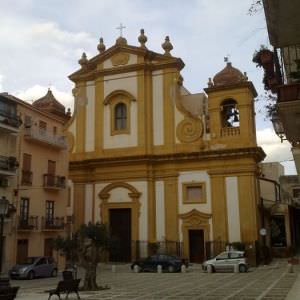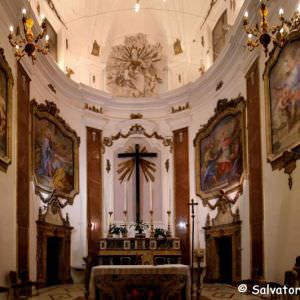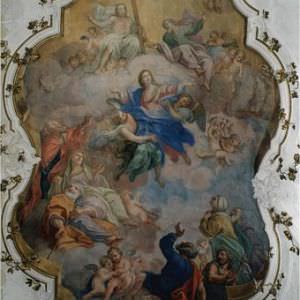The Cathedral
The Cathedral (known as "La Matrici") was built in the center of Castellammare, at the limits of the old walled city, on a spur of tufa rock that towers over the sea for about 25 meters. The construction began in May of 1726 by the Prince of Aragona and lord of Castellammare, Baldassare Naselli, to be opened for worship in January 1736. Actually, according to reports by the Archpriest D. Tommaso Accardi the date of 1726 refers to the third rebuilding of the church, which would arise on the foundations of earlier buildings. According to a deed dated 4 May 1726, the builder was Carlo Bruno from Palermo, while the building design is attributed to the architect Giuseppe Mariani who made the drawings, and also directed the work. Tied to the classical tradition, Mariani endeavor, in front of the Mother Church, a sleek and simple style, whose well-harmonized lines are also reflected inside the sacred building, where there is a large central nave, closely linked to the presbytery and side naves. Outside the church is open to the west with three input ports, corresponding to the three inner aisles. The plan is a Latin cross and the division between the aisles is carried out through three square columns on each side, holding up as many arches round. The separation between the sanctuary and the interior of the church, however, occurs via two steps and a balustrade in red marble. The church, dedicated to the Blessed Virgin of Relief, houses inside nine altars: the first is the main altar, surmounted by a precious wooden crucifix and dedicated, in fact, the Blessed Crucifix. In the left aisle is located, from the back of the church, the altar with the Simulacrum of Holy Mary of Relief, closed by two fine old cleared; the altar dedicated to Joseph; the one dedicated to Blessed Mary of Carmel; the altar of St. Vincenzo Ferreri with the statue of St. Rocco; to this last follows the marble baptismal font. In the right aisle, proceeding in the same order, are: the altar of Blessed Sacrament with the statue of St. Heart of Jesus; the altar of Holy Mary of the lamp; the altar of Blessed Apostles Peter and Andrew, the altar of St. Gaetano with the statue of St. Francesco of Assisi. The interior decoration, while being influenced by the Baroque style, nonetheless retains a certain lightness and simplicity, and is distinguished by stucco and tangles, which are flanked by frescoes and marbles. In particular, in one of the frescoes in the nave you can read the name of the artist who created them. We read "Ioseph Tresca fecit A.D. 1767 "; but other evidences show that was not only the Tresca do these frescoes. The writer Agostino Gallo, in fact, speaking of Joseph Velasquez says that he, in his youth, followed his master Giuseppe Tresca in Castellammare to paint three frescoes in the central vault of the Cathedral. And it is to Velasquez seems to we should give the fresco painting in the vault of the choir, which blends Old and New Testament. The scene depicts the descent of Christ Triumphant in limbo, surrounded by the main protagonists of the Old Testament. The pictorial space is divided into three floors, where the colors fade as you approach the summit, on which is the representation of Christ. The first register depicts King David with the harp, Moses with the tablets of the Law and the chief priest; in the second Adam and Eve. Regarding the other frescoes, one placed above the main entrance represents Esther who asks the grace for his people to King Aussero. The fresco painting above the presbytery arch depicting Judith instead. In the large central medallion depicts the Assumption of the Virgin Mary, raised by the Angels towards the Blessed Trinity, with the Father, represented as an old man white-bearded, the Son, who holds the cross, and the Holy Spirit as a dove.Back to monuments →



Follow us on